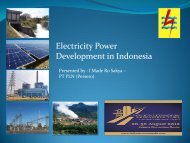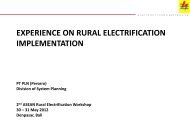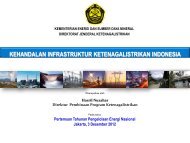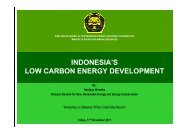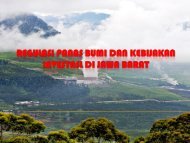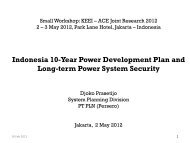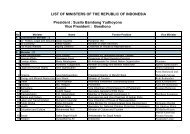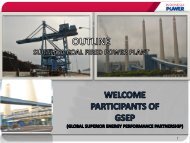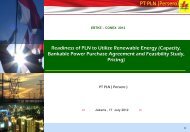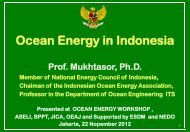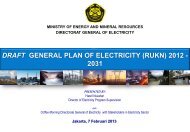energy efficiency and renewable energy in indonesia
energy efficiency and renewable energy in indonesia
energy efficiency and renewable energy in indonesia
You also want an ePaper? Increase the reach of your titles
YUMPU automatically turns print PDFs into web optimized ePapers that Google loves.
M<strong>in</strong>istry of Energy <strong>and</strong> M<strong>in</strong>eral ResourcesMINISTRY OF ENERGY AND MINERAL RESOURCES, REPUBLIC OF INDONESIADIRECTORATE GENERAL OF NEW RENEWABLE ENERGY AND ENERGY CONSERVATIONENERGY EFFICIENCYAND RENEWABLE ENERGY IN INDONESIABy:Dr. Ir. Djadjang SukarnaSecretary of Directorate General of New Renewable Energy <strong>and</strong> Energy ConservationPresented at:Japan - Indonesia 3 rd Energy Policy DialogueFukuoka, 12 – 13 July 2012
M<strong>in</strong>istry of Energy <strong>and</strong> M<strong>in</strong>eral ResourcesI. Energy ConditionII.III.IV.OUTLINEEnergy Policy DirectionDeployment of Policy Instruments for New,Renewable Energy- Geothermal- Bio<strong>energy</strong>- Hydro, Solar & W<strong>in</strong>dEnergy ConservationV. Masterplan Acceleration <strong>and</strong> Expansion of IndonesiaEconomic Development (MP3EI) 2011 – 2025V. Conclusion2
M<strong>in</strong>istry of Energy <strong>and</strong> M<strong>in</strong>eral Resources©2012 3
M<strong>in</strong>istry of Energy <strong>and</strong> M<strong>in</strong>eral ResourcesENERGY CONDITION 2011Oil47%2011 Total Energy Mix1176 million BOEGas24%NRE5%Coal24%The average of growth rate of <strong>energy</strong> consumptionis 7% per yearHigh dependence on fossil <strong>energy</strong> while it reservesare more limitedLess of development of <strong>energy</strong> <strong>in</strong>frastructureparticularly <strong>in</strong> rural / remote areas <strong>and</strong> outer isl<strong>and</strong>sUtilization of <strong>renewable</strong> <strong>energy</strong> <strong>and</strong> implementationof Energy Conservation is not optimalPublic access to <strong>energy</strong> (modern) is still limited,Electrification ratio (2011) is 72.95%Share of Non Fossil Energy ≈ 5%L<strong>in</strong>kage to environmental issues abaout mitigation ofclimate change44
M<strong>in</strong>istry of Energy <strong>and</strong> M<strong>in</strong>eral Resources©2012 5
Bus<strong>in</strong>essas usualPresidentRegulation5 / 2006Vision25/25M<strong>in</strong>istry of Energy <strong>and</strong> M<strong>in</strong>eral ResourcesPOLICY DIRECTIONNREOilGasOil1176Million BOE5 %24 %24%47%1649Million BOE2419Million BOE3298Million BOE3,1%34.6%20,6%41.7%3200Million BOE17%33%30%20%2785Million BOEENERGYCONSERVATION(15.6%)25 %NRE32%Coal20%Gas23%OilENERGYDIVERSIFICATION2011 2015 202020256
M<strong>in</strong>istry of Energy <strong>and</strong> M<strong>in</strong>eral ResourcesTWO MAIN POLICIES1. Energy Conservation to improve <strong>efficiency</strong> <strong>in</strong> <strong>energy</strong> utilizationfrom up-stream up to down-stream (Dem<strong>and</strong> Side) i.e <strong>in</strong>dustrial,transportation, household <strong>and</strong> commercial sector2. Energy Diversification to <strong>in</strong>crease new <strong>renewable</strong> <strong>energy</strong> share<strong>in</strong> national <strong>energy</strong> mix (Supply Side) as belowNew EnergyRenewable Energya. Liquefied Coal,a. Geothermal,b. Coal Bed Methane, b. Bio<strong>energy</strong>,c. Gasified Coal,c. Hydro,d. Nuclear,d. Solar,e. Hydrogen,e. W<strong>in</strong>d,f. Other Methanes. f. Ocean.7
M<strong>in</strong>istry of Energy <strong>and</strong> M<strong>in</strong>eral ResourcesSTRATEGY FRAMEWORK AND POLICY INSTRUMENTSSTRATEGY FRAMEWORK• Energy diversification: to <strong>in</strong>crease the utilization of new <strong>renewable</strong> <strong>energy</strong>.• Geothermal power plants• Biodiesel• Municipal solid waste power plants• Energy conservation: to have the sectors of household, commercial, <strong>in</strong>dustry, <strong>and</strong> transportation use the <strong>energy</strong> efficiently.• M<strong>and</strong>atory <strong>energy</strong> management for <strong>energy</strong> user > 6000 TOE/years• Labelization of <strong>energy</strong> <strong>efficiency</strong> products• Sosialization of <strong>energy</strong> <strong>efficiency</strong>• Transformation Energy management : to change the paradigm of <strong>energy</strong> management with orientation to use more NRE, alsoto develop small scale NRE with local resources.• Development of Self Suficient Energy Village (Desa M<strong>and</strong>iri Energi, DME)• Micro <strong>and</strong> pyco Hydro Powers• Solar Energy (Photo Voltaic) Home System (100 W)• Bio DigesterPOLICY INSTRUMENTSFiscal• Fiscal <strong>in</strong>centive for NRE development (Article 20 paragraph 5 Law No. 30/2007)• Pric<strong>in</strong>g for new <strong>renewable</strong> <strong>energy</strong> (Feed-<strong>in</strong> Tariff/FIT)• Renewable Portfolio St<strong>and</strong>ard (RPS)8
M<strong>in</strong>istry of Energy <strong>and</strong> M<strong>in</strong>eral Resources©2012 9
M<strong>in</strong>istry of Energy <strong>and</strong> M<strong>in</strong>eral ResourcesNONON FOSSIL ENERGYENERGY POTENTIALRESOURCES(SD)INSTALLEDCAPACITY (KT)RATIO KT/SD(%)1 2 3 4 5 = 4/31 Hydro 75.670 MW 6.654,29 MW 8,8%2 Geothermal 29.038 MW 1.226 MW 4,2%3 M<strong>in</strong>i/Micro Hydro 769,69 MW 228,983 MW 29,75%4 Biomass 49.810 MW 1.618,40 MW 3,25 %5 Solar Energy 4,80 kWh/m 2 /day 22,45 MW -6 W<strong>in</strong>d Energy 3 – 6 m/s 1,87 MW -7 Uranium 3.000 MW *) 30 MW **) 1.00*) only <strong>in</strong> Kalan – West Kalimantan**) non <strong>energy</strong>, only for researchNO FOSSIL ENERGY RESERVESPRODUCTIONPER YEARRESERVE TOPRODUCTIONRATIO1 2 3 4 5 = 4/31 Oil 4.0 billion barel 347 million barel 11 years2 Gas 104.71 TSCF 3212 BSCF 32 years3 Coal 28 billion ton 329 million ton 85 years10
M<strong>in</strong>istry of Energy <strong>and</strong> M<strong>in</strong>eral Resources11
M<strong>in</strong>istry of Energy <strong>and</strong> M<strong>in</strong>eral ResourcesNAD 2 WKP• Jaboi: 70 MW• Seulawah Agam: 130 MW54 GEOTHERMAL WORKING AREASUMUT 4 WKP• Sibayak – S<strong>in</strong>abung: 130 MW• Sibual – Buali: 750 MW• Sipaholon Ria-ria: 75 MW• Sorik Marapi: 200 MW• Simbolon Samosir: 155 MWJAMBI 1 WKP• Sungai Penuh: 70 MWSUMSEL 3 WKP• Lumut Balai: 250 MW• Rantau Dedap: 106 MW• Danau Ranau: 210 MWGORONTALO 1 WKP• Suwawa: 110 MWSULUT 2 WKP• Kotamobagu: 410 MW• Lahendong-Tompaso: 358 MWMALUT 2 WKP• Jailolo: 75 MW• Songa Wayaua: 140 MWSUMBAR 4 WKP• Bukit Kili: 83 MW• Gn Talang: 35 MW• Liki P<strong>in</strong>angawan: 400 MW• Bonjol: 200 MWBENGKULU 1 WKP• Tmbg Sawah-Hululais: 873 MWBANTEN 2 WKP• Kaldera Danau Banten: 115 MW• G. Endut: 80 MWBALI 1 WKP• Tabanan: 276 MWSULTENG 1 WKP• Marana: 35 MW• Bora Pulu: 123 MWLAMPUNG 3 WKP• Gn.Rajabasa: 91 MW• Suoh Sek<strong>in</strong>cau: 230 MW• Waypanas – Ulubelu: 556 MW• Danau Ranau: 210 MW JABAR 10 WKP• Way Ratai: 105 MW • Ciater - Tgkban Perahu: 60 MW• Cibeureum–Parabakti: 485 MW• Cibuni: 140 MW• Cisolok Cisukarame: 45 MW• Gn. Tampomas: 50 MW• Gn. Tgkuban Perahu: 100 MW• Kamojang-Darajat: 1465 MW• Karaha Cakrabuana: 725 MW• Pangalengan: 1106 MW• G. Ciremai: 150 MWJATENG 4 WKP• Baturaden: 175 MW• Dataran T<strong>in</strong>ggi Dieng: 780 MW• Guci: 79 MW• Gn. Ungaran: 100 MW• Umbul Telomoyo: 92 MWJATIM 3 WKP• Blawan – Ijen: 270 MW• Gn. Iyang Argopuro: 295 MW• Telaga Ngebel: 120 MWNTB 1 WKP• Hu'u Daha: 65 MWNTT 4 WKP• Atadei: 40 MW• Sokoria: 30 MW• Ulumbu: 199 MW• Mataloko: 63 MWMALUKU 1 WKP• Tulehu: 100 MW13
M<strong>in</strong>istry of Energy <strong>and</strong> M<strong>in</strong>eral ResourcesINSTALLED GEOTHERMAL POWER PLANT (GPP)GPP SIBAYAK: 12 MWGPP LAHENDONG: 80 MWGPP WAYANGWINDU: 227 MWGPP GUNUNG SALAK: 377 MWGPP KAMOJANG:200 MWGPP DARAJAT: 270 MWGPP DIENG: 60 MW14
M<strong>in</strong>istry of Energy <strong>and</strong> M<strong>in</strong>eral ResourcesINSTALLED GEOTHERMAL POWER PLANT CAPACITY 2012No.Geothermal Work<strong>in</strong>gArea /LocationLicense HolderDeveloperGeothermalPower PlantInstalledCapacity(MW)1Sibayak – S<strong>in</strong>abung,SUMUTPT. Pertam<strong>in</strong>a GeothermalEnergy (PGE)PT. Pertam<strong>in</strong>a GeothermalEnergy (PGE)Sibayak 122Cibeureum – Parabakti,JABARPT. Pertam<strong>in</strong>a GeothermalEnergy (PGE)KOB - Chevron GeothermalSalak, Ltd (CGS)Salak 3773 Pangalengan, JABARPT. Pertam<strong>in</strong>a GeothermalEnergy (PGE)KOB - Star EnergyGeothermal WayangW<strong>in</strong>du, Ltd (SEGWWL)WayangW<strong>in</strong>du2274Kamojang – Darajat,JABARPT. Pertam<strong>in</strong>a GeothermalEnergy (PGE)PT. Pertam<strong>in</strong>a GeothermalEnergy (PGE)Kamojang 2005Kamojang – Darajat,JABARPT. Pertam<strong>in</strong>a GeothermalEnergy (PGE)KOB - Chevron GeothermalIndonesia, Ltd (CGI)Darajat 2706Dataran T<strong>in</strong>ggi Dieng,JATENGPT. Pertam<strong>in</strong>a GeothermalEnergy (PGE)PT. Geo Dipa Energi (GDE) Dieng 607Lahendong – Tompaso,SULUTPT. Pertam<strong>in</strong>a GeothermalEnergy (PGE)PT. Pertam<strong>in</strong>a GeothermalEnergy (PGE)Lahendong 801.22615
M<strong>in</strong>istry of Energy <strong>and</strong> M<strong>in</strong>eral ResourcesSTRATEGICAL TARGETFOR GEOTHERMAL DEVELOPMENT 2010 S.D 2014Presidential Regulation No. 04/2010 on Assignment to PT. PLN to Accelerate Power PlantDevelopment Us<strong>in</strong>g Renewable Energy, Coal <strong>and</strong> GasMEMR Regulation No. 01/2012 as revised of M<strong>in</strong>isterial Regulation No. 15/2010 on ProjectsList of Power Plant Accelerated Development us<strong>in</strong>g Renewable Energy, Coal <strong>and</strong> Gas aswell as Related TransmissionTarget for Geothermal Power Plant Development on Crash Program 10.000 MWPhase II- Development for Production on Exist<strong>in</strong>g Field : 465 MW- Development for not yet <strong>in</strong> production on Exist<strong>in</strong>g Field : 1535 MW- New Development Geothermal Work<strong>in</strong>g Area : 2925 MWTotal of Geothermal Development4925 MW16
M<strong>in</strong>istry of Energy <strong>and</strong> M<strong>in</strong>eral ResourcesGOVERNMENT POLICIES TO SCALE UPGEOTHERMAL DEVELOPMENT IN INDONESIAThe Government of Indonesia (GoI) <strong>in</strong>tends to accelerate <strong>and</strong> speed up the development ofgeothermal. In order to do so, the government <strong>in</strong>tends to enhance the <strong>in</strong>vestment climate forboth exist<strong>in</strong>g developers as well as new entrants to the geothermal sector <strong>in</strong> Indonesia.1. Law No. 27/2003 on Geothermal <strong>and</strong> Government Regulations No. 59/2007 onGeothermal Bus<strong>in</strong>ess Activities jo Government Regulations No. 70/2010 are the basis ofgeothermal development Indonesia2. Presidential Regulation No. 04/2010 jo M<strong>in</strong>isterial Regulation No. 01/2012 as revised ofM<strong>in</strong>isterial Regulation No. 15/2010 (2 nd Stage of 10,000 MW Crash Program) <strong>in</strong> order tospeed up the development of geothermal power.3. Pric<strong>in</strong>g Policy• M<strong>in</strong>istrial Regulation of MEMR No. 02/2011 on geothermal price structure. The MRgives certa<strong>in</strong>ty on electricity price from geothermal power plant:- Electricity price as the result of a GWA tender, is represent as purchase price by PTPLN <strong>in</strong> the Power Purchase Agreement, which is f<strong>in</strong>al <strong>and</strong> non negotiable- Ceil<strong>in</strong>g price for geothermal <strong>energy</strong>: US$ 9.7 cents/kWh- If the price exceeds US$ 9.7 cents/kWh, negotiations between Parties are needed.17
M<strong>in</strong>istry of Energy <strong>and</strong> M<strong>in</strong>eral ResourcesGOVERNMENT POLICIES TO SCALE UP GEOTHERMALDEVELOPMENT IN INDONESIA (CONT’D)3. Pric<strong>in</strong>g Policy (cont’d)• Fiscal <strong>in</strong>centives for geothermal development (based on Government Regulation No.62/2008 jo No. 1/2007; MR of MoF No. 177/PMK.011/2007; <strong>and</strong> MR of MoF No.22/PMK.011/2011) :- 30% of corporate <strong>in</strong>come tax;- 10% of added-value tax paid by the GoI;- Custom duties exemption for geothermal developer;- 25% per year depreciation for 8 years with double decl<strong>in</strong><strong>in</strong>g balance method; <strong>and</strong>- Investment tax credit 5% per year for 6 years.• Currently the mechanism of Feed <strong>in</strong> Tariff for each GWA is be<strong>in</strong>g developed by the GoI<strong>in</strong> order to make geothermal bus<strong>in</strong>ess more attractive to <strong>in</strong>vestors.4. Access to Potential Geothermal Resources for Investors• The Government offers a Prelim<strong>in</strong>ary Survey Assignment to third party (<strong>in</strong>vestor) whichprovides “first right refusal”.• The GoI establishes new GWAs <strong>and</strong> widely open opportunities for <strong>in</strong>vestors toparticipate <strong>in</strong> the geothermal bus<strong>in</strong>ess through GWAs tender<strong>in</strong>g mechanism18
M<strong>in</strong>istry of Energy <strong>and</strong> M<strong>in</strong>eral ResourcesGOVERNMENT POLICIES TO SCALE UP GEOTHERMALDEVELOPMENT IN INDONESIA (CONT’D)5. In order to accelerate the tender process of new GWAs, the policies which regulatebidd<strong>in</strong>g process are be<strong>in</strong>g revised <strong>in</strong> order to make the tender more simple, transparent<strong>and</strong> bankable.6. Coord<strong>in</strong>at<strong>in</strong>g with all relevant parties to accelerate <strong>and</strong> simplify the permit process.7. Related to Forestry Issues, currently MEMR <strong>and</strong> M<strong>in</strong>istry of Forest have signed the MoUregard<strong>in</strong>g the acceleration of geothermal utilization permit with<strong>in</strong> production forest,protected forest, <strong>and</strong> conservation forest.8. The government has issued a Presidential Decree that guarantees support for <strong>in</strong>vestment<strong>in</strong> Geothermal Infrastructure Project (PR No. 13/2010 jo PR No.67/2005 <strong>and</strong> PR78/2010) <strong>and</strong> M<strong>in</strong>istrial of F<strong>in</strong>ance Regulation No. 139/2011 (PMK No. 139/2011) whichguarantee the bus<strong>in</strong>ess feasibility of PT PLN for develop<strong>in</strong>g electricity from <strong>renewable</strong><strong>energy</strong>, coal, <strong>and</strong> gas through cooperation with Independent Power Producers.19
M<strong>in</strong>istry of Energy <strong>and</strong> M<strong>in</strong>eral Resources20
M<strong>in</strong>istry of Energy <strong>and</strong> M<strong>in</strong>eral ResourcesIMPLEMENTATION OF BIOENERGY IN INDONESIA1. Development of biofuel as fossil fuel substitution:– There are 24 biodiesel produser <strong>and</strong> 14 bioethanol producer that have commercialbus<strong>in</strong>ess license to operate <strong>in</strong> Indonesia.– Installed capacity of biodiesel is 4,659,938 KL/year <strong>and</strong> <strong>in</strong>stalled capacity ofbioethanol is 463,980 KL/year.2. Development <strong>and</strong> utilization of “Mitanol” (kerosene from bioethanol) as kerosenesubstitution for household3. Development of biogas digester for cook<strong>in</strong>g <strong>in</strong> household sector through BIRU(Biogas Rumah) Programme as Indonesia Domestic Biogas Programme. Thisprogramme implemented by HIVOS, as NGO from Netherl<strong>and</strong>s <strong>and</strong> funded byNetherl<strong>and</strong>s Governtment. Status until April 5 th the total biogas digester that have beenbuilt is 4,963 unit.4. Development of power plant based on biomass with the total <strong>in</strong>stalled capacity is550 MW (biomass power plant waste, types of agriculture waste <strong>and</strong> types of municipalsolid waste).21
M<strong>in</strong>istry of Energy <strong>and</strong> M<strong>in</strong>eral ResourcesNoPOTENTIAL OF MUNICIPAL WASTE FOR ELECTRICITY GENERATION … (1)CityPopulation(People)Potential of CityWaste(ton/day)F<strong>in</strong>al Waste Disposal Site Location1 DKI Jakarta 9.703.000 8.733 B<strong>and</strong>ar Gebang, Sumur Batu2 Batam 636.729 450 Telaga Punggur3 Kota Semarang 1.495.000 1.345 Jatibarang4 Kota Palembang 1.301.000 1.171 Sukaw<strong>in</strong>ata, Karya Jaya5 Kota Surabaya 2.847.000 2.562 Benowo6 Kota Padang 758.000 682 Air D<strong>in</strong>g<strong>in</strong>7 Kota Pontianak 490.000 340 Batu Layang8 Kota Medan 2.014.000 1.812 Namo B<strong>in</strong>tang, Terjun9 Kota Bogor 3.600.000 3.240 Galuga10 Kota Malang 846.000 761 Supit Urang11 Kota Depok 1.352.000 1.217 Cipayung12 Kota Jogya, Sleman, Bantu 2.408.000 2.000 Ngablak-Piyung13 Kota Jambi 437.170 100 Talang Gulo14 Kota Samar<strong>in</strong>da 550.000 400 Bukit P<strong>in</strong>ang15 Kab. Bogor 3.600.000 3.240 Pondok Rajeg16 Kab. Tangerang 3.048.000 2.743 Jatiwar<strong>in</strong>g<strong>in</strong>17 Kota Sukabumi 2.210.000 1.989 Cigundul18 Kab. Garut 2.050.000 1.844 Basir Baj<strong>in</strong>g22
M<strong>in</strong>istry of Energy <strong>and</strong> M<strong>in</strong>eral ResourcesPOTENTIAL OF MUNICIPAL WASTE FOR ELECTRICITY GENERATION … (2)NoCityPopulation(People)Potential ofCity Waste(ton/day)19 Bali 1.896.000 445 Sarbagita S<strong>in</strong>garaja20 Kota Madiun 679.841 612 W<strong>in</strong>ongo21 Kab. Jember 2.346.000 2.112 PakusariF<strong>in</strong>al Waste Disposal Site Location22 Kab. Cianjur 1.958.000 1.762 Pasir Sembung, Pasir Bungur23 Kab. Malang 2.469.000 2.222 Talang Agung, R<strong>and</strong>u Agung24 Kab. Sidoarjo 1.742.000 1.568 Desa Kupang25 Kota Balikpapan 495.314 400 Manggar26 Kab. Banyuwangi 1.670.000 1.503 Bulusan, Rogojambi27 Kota B<strong>and</strong>ung 2.349.000 2.114 Leuwi Gajah28 Kota & Kab. Tegal 3.910.000 3.519 Sarimukti29 Kota & Kab. Cirebon 2.236.000 2.01230 Kota Tangerang 1.502.000 1.352 Rawakuc<strong>in</strong>g31 Surakarta, Klaten & Boyolali 2.719.000 2.44732 Kota & Kab. Tegal 1.650.000 1.48533 Kota & Kab. Pasuruan 1.350.000 1.21534 Kota & Kab. Probol<strong>in</strong>ggo 1.450.000 1.30035 Kota & Kab. Kediri 1.360.000 1.22436 Kota Pakanbaru 670.000 60337 Kota B<strong>and</strong>ar Lampung 782.000 70338 Kota Makasar 1.143.000 102923
M<strong>in</strong>istry of Energy <strong>and</strong> M<strong>in</strong>eral ResourcesELECTRICITY PRICE (FEED-IN TARIFF ) BASED ONENERGY BIOMASS, BIOGAS, AND MUNICIPAL SOLID WASTE * )No. Energy Capacity Electricity Tariff Note1. Biomass until 10 MW Rp. 975,- / kWh X F2. Biogas until 10 MW Rp. 975,- / kWh X FNon Municipal SolidWaste3. Municipal Solid Waste until 10 MW Rp. 1050,- / kWh Zero waste ** )4. Municipal Solid Waste unti 10 MW Rp. 850,- / kWh L<strong>and</strong>fill **)• F as an <strong>in</strong>centive factor based on the region where the power plant <strong>in</strong>stalled, as follows:Jawa, Bali, <strong>and</strong> Sumatera region : F = 1Kalimantan, Sulawesi , NTB <strong>and</strong> NTT region : F = 1,2Maluku <strong>and</strong> Papua region : F = 1,3• Feed <strong>in</strong> Tariff already issued <strong>in</strong> M<strong>in</strong>ister of ESDM decree No. 4/2012Note :* ) Connected to medium voltage system** ) - Based on Act No. 18 Year 2008 concern<strong>in</strong>g to Waste Management.- For municipal solid waste, tipp<strong>in</strong>g fee applied at m<strong>in</strong>imum Rp. 100.000, - / ton of waste24 24
M<strong>in</strong>istry of Energy <strong>and</strong> M<strong>in</strong>eral Resources25
M<strong>in</strong>istry of Energy <strong>and</strong> M<strong>in</strong>eral ResourcesMAP OF EXISTING MIKROHYDRO-POWERUtilization of Microhydropower potential <strong>in</strong> Indonesia has been developed<strong>in</strong> different regions26
M<strong>in</strong>istry of Energy <strong>and</strong> M<strong>in</strong>eral ResourcesPROGRAM OF SOLAR ENERGY, WIND ANDOCEAN ENERGY1. Rural Electricity: <strong>in</strong>creas<strong>in</strong>g rural community accessibility to electricity;target<strong>in</strong>g electricity dem<strong>and</strong> <strong>in</strong> remote area2. Urban Electricity: target<strong>in</strong>g middle <strong>and</strong> high class household, realestate, office <strong>and</strong> commercial build<strong>in</strong>gs, hotel <strong>and</strong> resort, <strong>in</strong>dustry <strong>and</strong>others3. Electricity for Frontier Isl<strong>and</strong>: target<strong>in</strong>g community <strong>in</strong> the isl<strong>and</strong> locatedalong the country border l<strong>in</strong>e27
M<strong>in</strong>istry of Energy <strong>and</strong> M<strong>in</strong>eral Resources28
M<strong>in</strong>istry of Energy <strong>and</strong> M<strong>in</strong>eral ResourcesLaw No. 30 / 2007On EnergyREGULATORY FRAMEWORKGovernment Regulation No.70/2009On Energy ConservationResponsibilityImplementation of EnergyConservationUPDATES ON REGULATIONM<strong>in</strong>isterial Regulation (MEMR) No.6/2011 on Energy Label<strong>in</strong>g for CFLSt<strong>and</strong>ard <strong>and</strong> Labell<strong>in</strong>gFacilitation, Incentive <strong>and</strong>Dis<strong>in</strong>centiveSupervision <strong>and</strong>Monitor<strong>in</strong>gPresidential Instruction No. 13/2011On Energy <strong>and</strong> Water Sav<strong>in</strong>gPresidential Regulation No. 61/2011on National Action Planon GHG Emission ReductionPresidential Regulation No. 5/2006On National Energy PolicyM<strong>in</strong>isterial Regulation (MEMR) No.13/2010 <strong>and</strong> No.14/2010 on CompetencySt<strong>and</strong>ards for Energy Manager29
M<strong>in</strong>istry of Energy <strong>and</strong> M<strong>in</strong>eral ResourcesLABELING FOR CFL• Objective : <strong>in</strong>troduc<strong>in</strong>g <strong>energy</strong> sav<strong>in</strong>g level as a guidance for consumer<strong>and</strong> to promote <strong>energy</strong> <strong>efficiency</strong>• Test<strong>in</strong>g procedure : SNI IEC 60969 : 2009• Label for <strong>energy</strong> sav<strong>in</strong>g marks : SNI 04-6958-2003• M<strong>in</strong>isterial Regulation (MEMR) No. 6/2011 on Energy Label<strong>in</strong>g for CFLwas issued as a legal basis• CFL as a pioneer for Label<strong>in</strong>g ProgramPower(Watt)Efication Value (Lumen/Watt)1 Star 2 Stars 3 Stars 4 Stars5 – 9 45 – 49 >49 – 52 >52 – 55 > 5510 – 15 46 – 51 > 51 – 54 > 54 – 57 > 5716 – 25 47 – 53 > 53 – 56 > 56 – 59 > 59≥ 26 48 – 55 > 55 – 58 > 58 – 61 > 6130
SampleTest reportM<strong>in</strong>istry of Energy <strong>and</strong> M<strong>in</strong>eral ResourcesSELF-DECLARATION OF CONFORMITY (SDOC) FOR CFLManufacturer& ImporterReportM<strong>in</strong>istry of Energy &M<strong>in</strong>eral ResourcesRetailersAccreditedLaboratoryConsumersMarketMarket Surveillance31
M<strong>in</strong>istry of Energy <strong>and</strong> M<strong>in</strong>eral ResourcesS & L PLAN IN 2011 - 2015CFLRefrigerator <strong>and</strong> Air ConditionerElectric Ballast, Fan, <strong>and</strong> TVRice Cooker <strong>and</strong> Electric MotorElectric Iron <strong>and</strong> Wash<strong>in</strong>g Mach<strong>in</strong>eYear2011 2012 2013 2014 201532
M<strong>in</strong>istry of Energy <strong>and</strong> M<strong>in</strong>eral Resources33 33
MASTERPLAN ACCELERATION AND EXPANSIONOF INDONESIA ECONOMIC DEVELOPMENT (MP3EI) 2011 – 2025M<strong>in</strong>istry of Energy <strong>and</strong> M<strong>in</strong>eral ResourcesPROJECT IN GEOTHERMAL POWER PLANT91028811377Sumatera EconomicCorridorJavaEconomicCorridorKalimantanEconomic CorridorSulawesiEconomic CorridorBali – Nusa TenggaraEconomic CorridorBali – Nusa TenggaraEconomic CorridorGovernment ProjectPrivate Sector Project34
MASTERPLAN ACCELERATION AND EXPANSIONOF INDONESIA ECONOMIC DEVELOPMENT (MP3EI) 2011 – 2025M<strong>in</strong>istry of Energy <strong>and</strong> M<strong>in</strong>eral ResourcesPROJECT IN HYDRO POWER PLANT22Sumatera EconomicCorridorJavaEconomicCorridorKalimantanEconomic CorridorSulawesiEconomic CorridorBali – Nusa TenggaraEconomic CorridorBali – Nusa TenggaraEconomic CorridorGovernment ProjectPrivate Sector Project35 35
M<strong>in</strong>istry of Energy <strong>and</strong> M<strong>in</strong>eral Resources36
M<strong>in</strong>istry of Energy <strong>and</strong> M<strong>in</strong>eral ResourcesCONCLUSION- Indonesia’s <strong>energy</strong> consumption is still dom<strong>in</strong>ated by fossil fuel (95%), while new <strong>and</strong><strong>renewable</strong> <strong>energy</strong> rema<strong>in</strong> as the alternative <strong>energy</strong> (less than 5%).- In effort to <strong>in</strong>crease the national <strong>energy</strong> security, the Government of Indonesiatransforms the <strong>energy</strong> paradigm by us<strong>in</strong>g <strong>renewable</strong> <strong>energy</strong> as the ma<strong>in</strong> source of<strong>energy</strong>, with fossil fuel as the alternative <strong>energy</strong>, <strong>and</strong> to implement <strong>energy</strong> conservation.Therefore our target is 25% of national <strong>energy</strong> mix is derived from the <strong>renewable</strong><strong>energy</strong>.- Indonesia has various potential of new <strong>and</strong> <strong>renewable</strong> <strong>energy</strong> such as geothermal,hydro power, biomass, wave current. Therefore, Partners <strong>and</strong> Investors are welcome to<strong>in</strong>vest <strong>in</strong> this field, as well as <strong>energy</strong> conservation.- The Government of Indonesia has issued many regulations as well as fiscal <strong>in</strong>centivesto make the <strong>renewable</strong> <strong>energy</strong> <strong>and</strong> <strong>energy</strong> conservation bus<strong>in</strong>ess more conducive.- The Government of Indonesia as for February 2012 has established as many as 50Geothermal Work<strong>in</strong>g Areas, giv<strong>in</strong>g <strong>in</strong>vestors opportunity to <strong>in</strong>vest <strong>in</strong> the Geothermalfields of the country.37
M<strong>in</strong>istry of Energy <strong>and</strong> M<strong>in</strong>eral ResourcesThank YouGo Green Indonesia !green <strong>energy</strong>, future <strong>energy</strong>MINISTRY OF ENERGY AND MINERAL RESOURCES REPUBLIC OF INDONESIADIRECTORATE GENERAL OF NEW, RENEWABLE ENERGY, AND ENERGY CONSERVATIONJalan Jenderal Gatot Subroto, Kav. 49 Jakarta 12950; Telp: 021-52904235; 5250575; Faks: 021-25529106; 25529212Email: bahan@ebtke.esdm.go.id ; bahan_ebtke@yahoo.comwww.ebtke.esdm.go.id38
MASTERPLAN ACCELERATION AND EXPANSIONOF INDONESIA ECONOMIC DEVELOPMENT (MP3EI) 2011 – 2025M<strong>in</strong>istry of Energy <strong>and</strong> M<strong>in</strong>eral ResourcesNoProject NameCapacity(MW)1 Sarulla 1102 Sungai Penuh 1103 Hulu Lais 1104 Lumut Balai Unit 1, 2, 3 <strong>and</strong> 4 2205 Ulubelu Unit 1 <strong>and</strong> 2 1106 Kamojang 407 Bedugul 108 Marana 209 Kotamobagu 8010Jailolo 10Songa Wayaua 511 Tulehu 20NoProject NameCapacity(MW)1 Jaboi 72 Feasibility Study P<strong>and</strong>eglang 11034Darajat 55Tampomas 45Salak 40Karaha Bodas 30Dieng 55Ungaran 555 Wilis/Ngebel 1106 Sembalun 207 Hu’u Daha 208Sokoria 10Atadei 53939
MASTERPLAN ACCELERATION AND EXPANSIONOF INDONESIA ECONOMIC DEVELOPMENT (MP3EI) 2011 – 2025M<strong>in</strong>istry of Energy <strong>and</strong> M<strong>in</strong>eral ResourcesNo Project Name Capacity (MW)No Project Name Capacity (MW)1 Rajam<strong>and</strong>ala 471 Asahan 3 174Ranteballa 22 Simpang Aur 402 Manipi 11Upper Cisokan 10003Karama 350Jatigede 110Hek 34 Kalikonto 62Pekasalo 15 Ratelimbong-Kolaka 2Mampueno 1Bonehau 4Wawopada 4Budaong – budaong 26Biak I 2Kalukku 1Biak II 1Balla 13Biak III 1Sansar<strong>in</strong>o 1Kotaraya 17 Tom<strong>in</strong>i 2Bambalo III 2Sawidago II 1Batubota 38 Feasibility Study MamberamoBunta 3Lambangan 3Sawadigo I 2Poso Energy 195Milangodaa 114Dum<strong>in</strong>anga 1Belengan 1Sawangan 1640 40



